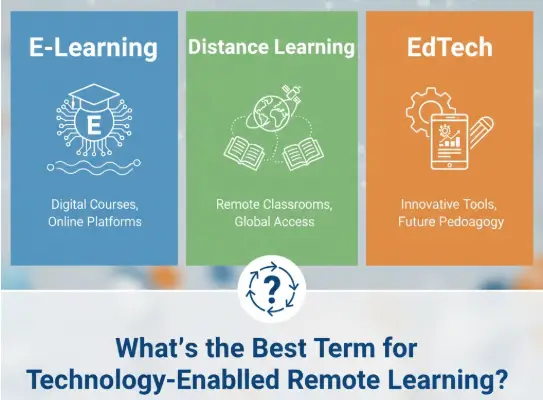Learning with technology is simple; you just need a phone, computer or internet. It could be a live class, a video you watch later or even a small app that teaches you new skills. This way of learning is everywhere now. Many people work from home and schools mix online and classroom lessons. Students can join from any city or country. It saves travel time, feels flexible and lets anyone keep learning no matter where they are. For more insights on tech trends visit Leatheling’s Tech Blog.
The Basics of Remote Learning
Remote learning means studying with a phone, tablet or laptop instead of sitting in a classroom. You can learn from anywhere—your room, the park, even grandma’s house.
Here’s what it looks like:
- Join live classes on Zoom or Google Classroom.
- Watch lessons on YouTube or Khan Academy.
- Do quizzes and homework on apps like Canvas.
Why Remote Learning Is Big
Remote learning grew fast during the 2020 pandemic—and it hasn’t slowed down. Here’s why people love it:
- Huge Reach: 90% of schools worldwide used online classes when classrooms closed.
- Flexible: Learn anytime—early morning or late at night.
- Open for All: Kids in small towns or big cities can join top classes from anywhere.
Why It Matters
Billions of devices connect to the internet every day. Remote learning makes school simple and open to everyone. Understanding Globalization.
Example: A kid learning to build a game by watching a YouTube video.
Why E-Learning Works So Well
E-learning is a great match for today’s tech world. Here’s why:
- Covers a Lot: From video lessons to quizzes—apps like Khan Academy and Coursera have it all.
- Learn Your Way: Go fast or slow, whenever you have time. Perfect for busy kids and adults.
- Fun to Use: Games, videos and cool apps make learning feel more like play.
Pros of E-Learning
- Learn Anytime: You pick the time—morning, night or even on the weekend.
- Fun Way to Learn: Videos, games and little quizzes keep things interesting.
- Used by Everyone: Schools, offices and training programs all rely on it now.
Cons of E-Learning
- Covers Too Much: It can mean any tech learning, even in a classroom, so it’s not always about learning from home.
- Feels Less Personal: You don’t always get one-on-one time with a teacher, and some people miss that.
What Is Distance Learning?
Distance learning means you and your teacher are not in the same place. It can be used:
- Video calls on Zoom or Google Classroom for live lessons.
- Online sites like Canvas are used to share homework and notes.
- In the past, even mail was used to send lessons!
It’s like having a teacher send lessons straight to you, no matter where you are.
Example: A student in Canada takes a history class from a teacher in the UK all online.
Why Distance Learning Works for Remote Learning
Distance learning is made for remote setups. Here’s why:
- All About Location: You can learn even when your teacher is far away. Zoom makes it easy.
- Great for Today: Perfect for online college or school days when you can’t go in.
- Used Everywhere: Schools and universities use it all the time for remote classes.
Example: A kid in Florida joins a math class on Zoom with a teacher in New York.
Pros of Distance Learning
- Easy to Get: Everyone knows it means learning from far away.
- Learn Anywhere: Home, a café, or even grandma’s house—it still works.
- Tried and True: It’s been used for years, from old mail lessons to Zoom classes today.
Cons of Distance Learning
- Sounds a Bit Old: The word “distance” can feel old-fashioned, not super modern.
- Not the Top Choice: In 2025, only around 6 out of 10 teachers said they like using this term.
What Is EdTech?
EdTech stands for education technology. It’s all about using tech to make learning simple and fun. This can be an app, a website, or even a gadget that helps students and teachers. You can use it in class or at home.
Here are some examples:
- Smart Apps: Like having a tutor in your pocket. They give you practice questions that match your level.
- VR Headsets: You can “walk” through a museum, visit space, or explore the ocean without leaving your room.
- Learning Websites: Tools like Google Classroom or Blackboard, where teachers share homework, quizzes, and grades.
Why EdTech Works for Remote Learning
EdTech is perfect for remote learning because it mixes tech and education. You can use it anywhere—at home, in a café, or while traveling. Here’s why it works so well:
- Tech Powered: Videos, apps, and websites make learning easy from any place.
- Good for Everyone: Kids, college students, and even adults can all use it.
- Fun to Learn: Games, quizzes, and VR make lessons exciting and keep you hooked.
Example: A student in India explores the pyramids with a VR app while learning history at home. For more on innovative tech, see https://www.edutopia.org/topic/ed-tech/.
Pros of EdTech
- Fun to Use: EdTech makes learning feel like a game. Kids can use apps, watch videos, or explore 3D simulations. Many children say it’s fun because it doesn’t feel like schoolwork.
- Adjusts to You: Lessons can match your level. If something is too easy or hard, the app changes it so it fits you.
- Used by Teachers: A lot of teachers use EdTech every week. Tools like Quizlet or Google Classroom help them share lessons and quizzes.
- Helps Students Far Away: Even kids in small towns or far villages can learn. Some apps work offline or with low internet, so learning never stops.
Cons of EdTech
- Can Cost a Lot: Some tools, like VR headsets or fast internet, are expensive. Not all schools or families can pay for them.
- Needs Good Devices: Slow internet or old computers make using EdTech hard. Many teachers face this problem.
- Covers Too Much: “EdTech” can mean anything—from a calculator to AI apps. This can be confusing.
Benefits of Technology-Enabled Remote Learning
- Learn Anywhere: You can study at home, in the park, or at a friend’s house. No need to go to school.
- Saves Money: Online classes can be cheaper. You don’t need to pay for travel, books, or lunch at school.
- Go at Your Own Speed: Lessons can match how fast or slow you want to learn.
- Connects Everyone: Kids from different towns or countries can join the same class and learn together.
Example: A student in Lahore can take a math class from a teacher in London using a tablet—all from home.
Popular Tools and Platforms
Remote learning uses apps and websites to make studying easy and fun. You can learn from home, a café, or anywhere else. These tools help you keep up with classes and fit learning into your own schedule.
Learning Management Systems (Moodle, Canvas, Google Classroom)
Learning Management Systems, or LMS, are like digital notebooks. Teachers can share lessons, quizzes, and grades. Students log in to check homework and see how they are doing. They are very popular in schools for online or mixed classes.
- Moodle: Moodle is free and open to everyone. Millions of people use it worldwide. In 2024, over 400 million people visited Moodle sites, and 200 million learning resources were shared. Teachers like it because they can set it up their own way. In Europe, 8 out of 10 teachers choose Moodle.
- Canvas: Canvas is the most popular LMS in North America. In 2023, it had about 41% of the market. By 2025, it will have 30 million users, up from 25 million in 2023. More than 11,000 schools use it. Students like it too—7 out of 10 rate it 5 stars for mobile use.
- Google Classroom: Google Classroom is free and easy to use. It is available in 150 countries. In 2024, 10 million people used it daily on Android, with 28 million downloads. About 6.2 million teachers use it for 150 million students worldwide. Kids like it too—65% of children aged 8–12 say they enjoy using it for quick homework.
Video Conferencing Tools (Zoom, MS Teams)
Video tools let teachers and students see and talk to each other online. It’s like a classroom on your computer or tablet. These tools are great for live lessons or group work from home.
- Zoom: Zoom is very popular for school calls. In 2024, 300 million meetings happened every day, up from 200 million before 2023. By 2025, over 95% of big schools will use it. Teachers like it because it’s easy to share screens. Kids in small towns or rural areas like it too, since they don’t need to travel to class.
- MS Teams: MS Teams are made for schools. It lets teachers and students chat, share files, and take quizzes. In 2024, 320 million people used it, with 40 million in education. Many schools added new features and even AI tools by 2025. Parents like it too—8 out of 10 said it helps them check kids’ work quickly.
EdTech Apps (Khan Academy, Coursera, Duolingo)
These apps help you learn skills like math, languages, or job training. You can study at home using videos, games, and quizzes. They are perfect for learning on your own.
- Khan Academy: Khan Academy is free for all ages. In 2025, about 120 million people used it. Kids spent a lot of time learning—7.7 billion minutes in one year. Students who use it around 30 minutes a week can grow 30% faster in math. Teachers say most students want to keep using it because it’s fun and helpful.
- Coursera: Coursera is for college courses and job skills. By the end of 2024, 168 million people were registered. Women now make up almost half of learners. Many people take AI and real-world skills classes, and most give very high ratings for helpful lessons.
- Duolingo: Duolingo makes learning languages fun with daily games. In 2024, it had 37 million daily users and 575 million total users. English is the most popular language. Some users, like in Japan, study twice as much, and many stick with it just for the streaks.
Future Trends in Remote Learning
Remote learning is changing fast. New tools make learning at home easier and more fun. In 2025, things like AI helpers, games, short lessons, and safe online records are helping students do better. These tools work for kids and grown-ups, no matter where they are. Below are simple facts from real teachers and studies. They show why these ideas are useful and why people like them.
AI-Powered Tutoring
AI tutors are like smart helpers that give lessons just for you. They watch how you learn and adjust lessons to fit your speed. It feels like having a personal teacher at home.
- In 2025, AI tutors are growing fast. The market went from $1.6 billion in 2024 to $8 billion by 2030.
- Kids using AI tutors scored higher in math. Teachers in China said AI helps students learn faster.
- Most students like AI tools, and teachers say they save time for fun lessons.
- Schools using AI saw kids go to class more often and feel more confident. Grades went up quickly.
Games and VR/AR Learning
Adding games to lessons makes learning exciting. VR (virtual reality) and AR (augmented reality) let you explore worlds like space or history without leaving home.
- VR helps kids remember more than reading books. AR makes lessons feel real, and test scores go up.
- Gamified apps keep kids interested and turn playtime into learning.
- Many students ask for more VR and AR lessons after trying them.
- VR can even help with job skills, like nursing, and improve memory.
Microlearning – Short Lessons
Microlearning means short lessons, like 5-minute videos or quick quizzes. You can learn one thing at a time, even on a phone, which fits busy days.
- The market for short courses grew to $3 billion in 2025.
- People finish short lessons more than long ones. Kids remember more from quick videos.
- Mobile lessons are popular—they make learning fast and fun.
- Short courses cost less and let teens do homework easily on the go.
Blockchain for Credentials
Blockchain keeps grades and certificates safe online. It makes sure your school records are real and easy to share.
- Blockchain stops fake degrees and makes job checks faster. Many colleges use it now.
- It helps learners show skills on sites like LinkedIn. Employers can quickly verify them.
- Blockchain is growing fast and helps students keep their records for life.
- Students feel safe using digital badges, and many share proofs without paper.
For more on how blockchain is transforming education, visit https://www.forbes.com/sites/forbestechcouncil/2023/08/15/blockchain-in-education/.
Which Term Should You Use?
Choosing the right term depends on who you are and what you do.
- E-Learning: Use this when talking about online courses or apps for learning anywhere. It works for schools, colleges, and job training.
- Distance Learning: This fits best when students and teachers are in different places. Think online school or virtual college classes.
- EdTech: This is for all the tools and apps that make learning easier, like apps, VR, or AI tutors.
FAQs
What is the difference between e-learning and online learning?
E-learning is a broad term for learning with digital tools, like apps or videos. Online learning usually means taking classes on the internet. They are similar, but e-learning can happen in school too, not just at home.
Is EdTech only for schools?
No. EdTech is any tool that helps learning. Schools, colleges, offices, or even home learners can use it. Apps, games, and AI tutors all count as EdTech.
Can distance learning replace traditional classrooms?
It can for some lessons, but not all. Distance learning works well for online classes and self-study. Many people use it along with regular classrooms for a mix of learning.


